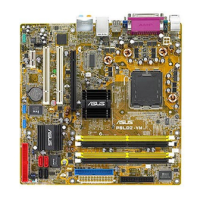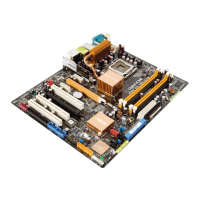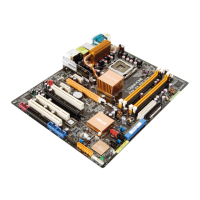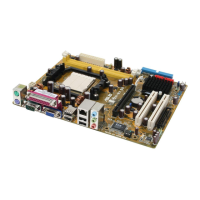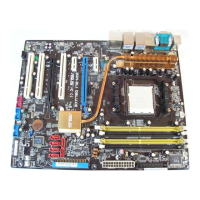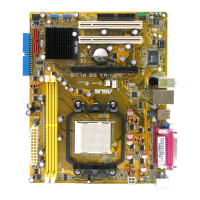Do you have a question about the Asus M2N-VM DH and is the answer not in the manual?
Welcomes the user and introduces the motherboard.
Lists the items included in the motherboard package.
Highlights various innovative and special features of the motherboard.
Explains how to manage and update the motherboard BIOS using various utilities.
Guides users on how to use the BIOS setup program for system configuration.
Details how to change settings for the CPU and other system devices in the Advanced menu.
Covers settings for Advanced Configuration and Power Interface (ACPI) and APM.
Allows changing system boot options and configuring boot settings.
Explains options for special functions like BIOS profiles and EZ Flash.
Covers loading default BIOS values and saving or discarding changes.
Details the contents of the support CD, including drivers and utilities.
Explains how to run the support CD and access its menu.
Lists available device drivers and explains their installation.
Lists applications and software supported by the motherboard.
Allows creating a RAID driver disk for NVIDIA and JMicron controllers.
Lists supplementary user manuals available on the support CD.
Displays the support CD contents in graphical format.
Displays the support CD contents and descriptions in text format.
Explains the process of creating a RAID driver disk for OS installation.
States compliance with FCC rules for digital devices.
States compliance with Canadian regulations for digital apparatus.
Provides precautions to prevent electrical shock hazards.
Outlines safe practices for installing and operating the motherboard.
Details CPU socket, supported processors, and features like Cool 'n' Quiet.
Lists the chipset used and its main components.
Specifies the front side bus speed supported by the motherboard.
Describes memory architecture, socket count, and supported DDR2 modules.
Lists the types and number of expansion slots available on the motherboard.
Details the integrated graphics processor and its output capabilities.
Explains storage interfaces, controllers, and RAID support.
Describes the audio codec and its features.
Details the Gigabit LAN controller and wireless LAN capabilities.
Specifies the number of USB 2.0 ports supported.
Describes overclocking features such as Precision Tweaker and C.P.R.
Details BIOS features like Flash ROM size and supported standards.
Lists all ports and connectors on the motherboard's rear panel.
Lists all internal connectors on the motherboard.
Specifies the ATX power supply requirements for the motherboard.
Highlights various innovative and special features of the motherboard.
Details key features like processor support and memory.
Explains the AMD Cool ‘n’ Quiet technology for temperature and power management.
Describes the NVIDIA nForce chipset and its storage management features.
Details the DDR2 memory support, bandwidth, and architecture.
Explains the PCI Express interface and its advantages.
Details Serial ATA technology, bandwidth, and SATA-On-The-Go features.
Introduces various innovative features developed by ASUS.
Explains the BIOS recovery tool for corrupted BIOS data.
Describes the user-friendly BIOS update utility.
Details the wireless networking feature for creating a home network.
Lists precautions to take before installing motherboard components.
Provides a diagram and description of the motherboard layout and component placement.
Explains the correct orientation for installing the motherboard in the chassis.
Provides step-by-step instructions for installing the CPU into the socket.
Details the process of installing the CPU heatsink and fan assembly.
Explains recommended memory configurations for single and dual-channel operation.
Advises on memory limitations when installing Windows XP 32-bit.
Lists qualified vendors and models for DDR2-800 MHz memory.
Lists qualified vendors and models for DDR2-667 MHz memory.
Lists qualified vendors and models for DDR2-533 MHz memory.
Provides step-by-step instructions for installing a DIMM into the socket.
Details the procedure for removing a DIMM from the socket.
Guides on how to install an expansion card into the motherboard slots.
Shows standard IRQ assignments and their functions.
Describes the PCI slots and the types of cards they support.
Explains the PCI Express x1 slot and compatible cards.
Details the PCI Express x16 slot and compatible graphics cards.
Explains how to clear the CMOS RTC RAM using the CLRTC jumper.
Details jumpers for USB device wake-up from sleep modes.
Describes the jumper for enabling onboard DVI or PCI Express slots.
Details the PS/2, VGA, USB, LAN, Audio, and DVI-D ports on the rear panel.
Details internal connectors like Floppy drive, IDE, Chassis intrusion, MP3-In, SATA, Fan connectors, COM.
Explains the IDE connector for Ultra DMA 133/100/66 signal cables.
Details the connector for the MP3-In module.
Explains Serial ATA connectors for SATA 3.0 Gb/s drives and RAID configurations.
Details fan connectors for CPU, Chassis, Power, and Chip fans, supporting Q-Fan.
Details 10-1 pin connectors for USB 2.0 ports.
Details the JMicron SATA connector for RAID configurations.
Details the front panel audio connector for HD Audio or AC'97.
Details the parallel port connector for LPT modules.
Details the ATX power connectors and PSU recommendations.
Details the system panel connector for chassis-mounted functions like LEDs and buttons.
Introduces the chapter on changing system settings through BIOS Setup menus.
Details steps for updating the BIOS via an internet connection.
Provides instructions for updating the BIOS using a BIOS file from disk.
Guides on creating a bootable floppy disk for DOS, Windows XP, and Windows 2000.
Explains the ASUS EZ Flash 2 utility for updating BIOS without DOS.
Details using AwardBIOS Flash Utility to update the BIOS in DOS mode.
Explains how to save the current BIOS file using AwardBIOS Flash Utility.
Explains the ASUS CrashFree BIOS 2 utility for recovering a corrupted BIOS.
Describes the layout and elements of the BIOS menu screen.
Explains the main items in the BIOS menu bar for navigation.
Describes the legend bar at the bottom of the BIOS setup screen.
Describes configuration fields and how to change their values.
Explains how pop-up windows display configuration options for menu items.
Provides an overview of the basic system information displayed in the Main BIOS menu.
Explains how BIOS detects IDE devices and their configuration.
Explains how BIOS detects SATA devices and their configuration.
Allows enabling or disabling HDD Self-Monitoring Analysis and Reporting Technology.
Covers CPU overclocking options and DRAM timing control.
Allows enabling/disabling AMD Live! and AMD Cool ‘n’ Quiet features.
Details chipset settings like Frame Buffer Size, HT Speed, and Spread Spectrum.
Explains Plug & Play OS settings, resource control, and IRQ assignments.
Allows enabling/disabling onboard devices like IDE, SATA, LAN, and Audio.
Covers USB controller settings and legacy USB support.
Details power management settings like Restore on AC Power Loss and Power Up options.
Displays hardware monitor values and allows CPU Q-Fan configuration.
Allows changing system boot options and configuring boot settings.
Specifies the boot device priority sequence from available devices.
Configures boot settings like Quick Boot, Floppy Seek, and NumLock state.
Allows setting Supervisor and User passwords to secure the BIOS and system.
Explains options for special functions like BIOS profiles and EZ Flash.
Allows storing or loading multiple BIOS settings and profiles.
Allows saving the current BIOS file to BIOS Flash or disk.
Allows running ASUS EZ Flash 2 for BIOS updates.
Covers loading default BIOS values and saving or discarding changes.
Saves selected BIOS values to CMOS RAM and exits the setup menu.
Loads default values for BIOS parameters.
Introduces the chapter describing the contents of the support CD.
Explains how to run the support CD and access its menu.
Indicates the locations for securing the motherboard with screws.
Details the procedure for removing a DIMM from the socket.
Explains how to configure an expansion card after installation via software settings.
Details IRQ assignments specifically for this motherboard's PCI slots.
Explains Serial ATA connectors for SATA 3.0 Gb/s drives and RAID configurations.
Details the serial port connector for COM port modules.
Details the 4-pin connector for optical drive audio input.
Details the digital audio connector for S/PDIF port.
Details the parallel port connector for LPT modules.
Details steps for updating the BIOS via an internet connection.
Guides on creating a bootable floppy disk for DOS, Windows XP, and Windows 2000.
Explains the ASUS EZ Flash 2 utility for updating BIOS without DOS.
Details using AwardBIOS Flash Utility to update the BIOS in DOS mode.
Explains how to save the current BIOS file using AwardBIOS Flash Utility.
Explains the ASUS CrashFree BIOS 2 utility for recovering a corrupted BIOS.
Describes the layout and elements of the BIOS menu screen.
Explains the main items in the BIOS menu bar for navigation.
Describes the legend bar at the bottom of the BIOS setup screen.
Describes configuration fields and how to change their values.
Explains how pop-up windows display configuration options for menu items.
Allows setting the system time in the BIOS.
Explains how BIOS detects SATA devices and their configuration.
Details how to change settings for the CPU and other system devices in the Advanced menu.
Covers CPU overclocking options and DRAM timing control.
Allows enabling/disabling AMD Live! and AMD Cool ‘n’ Quiet features.
Details chipset settings like Frame Buffer Size, HT Speed, and Spread Spectrum.
Explains Plug & Play OS settings, resource control, and IRQ assignments.
Allows enabling/disabling onboard devices like IDE, SATA, LAN, and Audio.
Covers USB controller settings and legacy USB support.
Details power management settings like Restore on AC Power Loss and Power Up options.
Displays hardware monitor values and allows CPU Q-Fan configuration.
Allows changing system boot options and configuring boot settings.
Specifies the boot device priority sequence from available devices.
Configures boot settings like Quick Boot, Floppy Seek, and NumLock state.
Allows setting Supervisor and User passwords to secure the BIOS and system.
Explains options for special functions like BIOS profiles and EZ Flash.
Allows storing or loading multiple BIOS settings and profiles.
Allows saving the current BIOS file to BIOS Flash or disk.
Allows running ASUS EZ Flash 2 for BIOS updates.
Covers loading default BIOS values and saving or discarding changes.
Saves selected BIOS values to CMOS RAM and exits the setup menu.
Loads default values for BIOS parameters.
Welcomes the user and introduces the motherboard.
Lists the items included in the motherboard package.
Highlights various innovative and special features of the motherboard.
Explains how to manage and update the motherboard BIOS using various utilities.
Guides users on how to use the BIOS setup program for system configuration.
Details how to change settings for the CPU and other system devices in the Advanced menu.
Covers settings for Advanced Configuration and Power Interface (ACPI) and APM.
Allows changing system boot options and configuring boot settings.
Explains options for special functions like BIOS profiles and EZ Flash.
Covers loading default BIOS values and saving or discarding changes.
Details the contents of the support CD, including drivers and utilities.
Explains how to run the support CD and access its menu.
Lists available device drivers and explains their installation.
Lists applications and software supported by the motherboard.
Allows creating a RAID driver disk for NVIDIA and JMicron controllers.
Lists supplementary user manuals available on the support CD.
Displays the support CD contents in graphical format.
Displays the support CD contents and descriptions in text format.
Explains the process of creating a RAID driver disk for OS installation.
States compliance with FCC rules for digital devices.
States compliance with Canadian regulations for digital apparatus.
Provides precautions to prevent electrical shock hazards.
Outlines safe practices for installing and operating the motherboard.
Details CPU socket, supported processors, and features like Cool 'n' Quiet.
Lists the chipset used and its main components.
Specifies the front side bus speed supported by the motherboard.
Describes memory architecture, socket count, and supported DDR2 modules.
Lists the types and number of expansion slots available on the motherboard.
Details the integrated graphics processor and its output capabilities.
Explains storage interfaces, controllers, and RAID support.
Describes the audio codec and its features.
Details the Gigabit LAN controller and wireless LAN capabilities.
Specifies the number of USB 2.0 ports supported.
Describes overclocking features such as Precision Tweaker and C.P.R.
Details BIOS features like Flash ROM size and supported standards.
Lists all ports and connectors on the motherboard's rear panel.
Lists all internal connectors on the motherboard.
Specifies the ATX power supply requirements for the motherboard.
Highlights various innovative and special features of the motherboard.
Details key features like processor support and memory.
Explains the AMD Cool ‘n’ Quiet technology for temperature and power management.
Describes the NVIDIA nForce chipset and its storage management features.
Details the DDR2 memory support, bandwidth, and architecture.
Explains the PCI Express interface and its advantages.
Details Serial ATA technology, bandwidth, and SATA-On-The-Go features.
Introduces various innovative features developed by ASUS.
Explains the BIOS recovery tool for corrupted BIOS data.
Describes the user-friendly BIOS update utility.
Details the wireless networking feature for creating a home network.
Lists precautions to take before installing motherboard components.
Provides a diagram and description of the motherboard layout and component placement.
Explains the correct orientation for installing the motherboard in the chassis.
Provides step-by-step instructions for installing the CPU into the socket.
Details the process of installing the CPU heatsink and fan assembly.
Explains recommended memory configurations for single and dual-channel operation.
Advises on memory limitations when installing Windows XP 32-bit.
Lists qualified vendors and models for DDR2-800 MHz memory.
Lists qualified vendors and models for DDR2-667 MHz memory.
Lists qualified vendors and models for DDR2-533 MHz memory.
Provides step-by-step instructions for installing a DIMM into the socket.
Details the procedure for removing a DIMM from the socket.
Guides on how to install an expansion card into the motherboard slots.
Shows standard IRQ assignments and their functions.
Describes the PCI slots and the types of cards they support.
Explains the PCI Express x1 slot and compatible cards.
Details the PCI Express x16 slot and compatible graphics cards.
Explains how to clear the CMOS RTC RAM using the CLRTC jumper.
Details jumpers for USB device wake-up from sleep modes.
Describes the jumper for enabling onboard DVI or PCI Express slots.
Details the PS/2, VGA, USB, LAN, Audio, and DVI-D ports on the rear panel.
Details internal connectors like Floppy drive, IDE, Chassis intrusion, MP3-In, SATA, Fan connectors, COM.
Explains the IDE connector for Ultra DMA 133/100/66 signal cables.
Details the connector for the MP3-In module.
Explains Serial ATA connectors for SATA 3.0 Gb/s drives and RAID configurations.
Details fan connectors for CPU, Chassis, Power, and Chip fans, supporting Q-Fan.
Details 10-1 pin connectors for USB 2.0 ports.
Details the JMicron SATA connector for RAID configurations.
Details the front panel audio connector for HD Audio or AC'97.
Details the parallel port connector for LPT modules.
Details the ATX power connectors and PSU recommendations.
Details the system panel connector for chassis-mounted functions like LEDs and buttons.
Introduces the chapter on changing system settings through BIOS Setup menus.
Details steps for updating the BIOS via an internet connection.
Provides instructions for updating the BIOS using a BIOS file from disk.
Guides on creating a bootable floppy disk for DOS, Windows XP, and Windows 2000.
Explains the ASUS EZ Flash 2 utility for updating BIOS without DOS.
Details using AwardBIOS Flash Utility to update the BIOS in DOS mode.
Explains how to save the current BIOS file using AwardBIOS Flash Utility.
Explains the ASUS CrashFree BIOS 2 utility for recovering a corrupted BIOS.
Describes the layout and elements of the BIOS menu screen.
Explains the main items in the BIOS menu bar for navigation.
Describes the legend bar at the bottom of the BIOS setup screen.
Describes configuration fields and how to change their values.
Explains how pop-up windows display configuration options for menu items.
Provides an overview of the basic system information displayed in the Main BIOS menu.
Explains how BIOS detects IDE devices and their configuration.
Explains how BIOS detects SATA devices and their configuration.
Allows enabling or disabling HDD Self-Monitoring Analysis and Reporting Technology.
Covers CPU overclocking options and DRAM timing control.
Allows enabling/disabling AMD Live! and AMD Cool ‘n’ Quiet features.
Details chipset settings like Frame Buffer Size, HT Speed, and Spread Spectrum.
Explains Plug & Play OS settings, resource control, and IRQ assignments.
Allows enabling/disabling onboard devices like IDE, SATA, LAN, and Audio.
Covers USB controller settings and legacy USB support.
Details power management settings like Restore on AC Power Loss and Power Up options.
Displays hardware monitor values and allows CPU Q-Fan configuration.
Allows changing system boot options and configuring boot settings.
Specifies the boot device priority sequence from available devices.
Configures boot settings like Quick Boot, Floppy Seek, and NumLock state.
Allows setting Supervisor and User passwords to secure the BIOS and system.
Explains options for special functions like BIOS profiles and EZ Flash.
Allows storing or loading multiple BIOS settings and profiles.
Allows saving the current BIOS file to BIOS Flash or disk.
Allows running ASUS EZ Flash 2 for BIOS updates.
Covers loading default BIOS values and saving or discarding changes.
Saves selected BIOS values to CMOS RAM and exits the setup menu.
Loads default values for BIOS parameters.
Introduces the chapter describing the contents of the support CD.
Explains how to run the support CD and access its menu.
Indicates the locations for securing the motherboard with screws.
Details the procedure for removing a DIMM from the socket.
Explains how to configure an expansion card after installation via software settings.
Details IRQ assignments specifically for this motherboard's PCI slots.
Explains Serial ATA connectors for SATA 3.0 Gb/s drives and RAID configurations.
Details the serial port connector for COM port modules.
Details the 4-pin connector for optical drive audio input.
Details the digital audio connector for S/PDIF port.
Details the parallel port connector for LPT modules.
Details steps for updating the BIOS via an internet connection.
Guides on creating a bootable floppy disk for DOS, Windows XP, and Windows 2000.
Explains the ASUS EZ Flash 2 utility for updating BIOS without DOS.
Details using AwardBIOS Flash Utility to update the BIOS in DOS mode.
Explains how to save the current BIOS file using AwardBIOS Flash Utility.
Explains the ASUS CrashFree BIOS 2 utility for recovering a corrupted BIOS.
Describes the layout and elements of the BIOS menu screen.
Explains the main items in the BIOS menu bar for navigation.
Describes the legend bar at the bottom of the BIOS setup screen.
Describes configuration fields and how to change their values.
Explains how pop-up windows display configuration options for menu items.
Allows setting the system time in the BIOS.
Explains how BIOS detects SATA devices and their configuration.
Details how to change settings for the CPU and other system devices in the Advanced menu.
Covers CPU overclocking options and DRAM timing control.
Allows enabling/disabling AMD Live! and AMD Cool ‘n’ Quiet features.
Details chipset settings like Frame Buffer Size, HT Speed, and Spread Spectrum.
Explains Plug & Play OS settings, resource control, and IRQ assignments.
Allows enabling/disabling onboard devices like IDE, SATA, LAN, and Audio.
Covers USB controller settings and legacy USB support.
Details power management settings like Restore on AC Power Loss and Power Up options.
Displays hardware monitor values and allows CPU Q-Fan configuration.
Allows changing system boot options and configuring boot settings.
Specifies the boot device priority sequence from available devices.
Configures boot settings like Quick Boot, Floppy Seek, and NumLock state.
Allows setting Supervisor and User passwords to secure the BIOS and system.
Explains options for special functions like BIOS profiles and EZ Flash.
Allows storing or loading multiple BIOS settings and profiles.
Allows saving the current BIOS file to BIOS Flash or disk.
Allows running ASUS EZ Flash 2 for BIOS updates.
Covers loading default BIOS values and saving or discarding changes.
Saves selected BIOS values to CMOS RAM and exits the setup menu.
Loads default values for BIOS parameters.
| ECC | No |
|---|---|
| Number of memory slots | 4 |
| Maximum internal memory | 8 GB |
| Processor socket | Socket AM2 |
| Processor manufacturer | AMD |
| Maximum number of SMP processors | 1 |
| USB 2.0 connectors | 2 |
| S/PDIF out connector | Yes |
| Number of SATA connectors | 5 |
| I/O ports | 1x WiFi-AP Solo antenna |
| Special features | ASUS WiFi-AP Solo Asus DH Remote ASUS MP3-In ASUS C.P.R. Q-Fan2 MyLogo2 EZ Flash 2 |
| Manageability features | WfM 2.0, DMI 2.0, WOL by PME, WOR by PME, PXE, Chassis Intrusion |
| Controller interface type | JMicron JMB363 |
| Controller 2nd interface type | NVIDIA nForce 430 |
| USB 2.0 ports quantity | USB 2.0 ports have a data transmission speed of 480 Mbps, and are backwards compatible with USB 1.1 ports. You can connect all kinds of peripheral devices to them. |
| Audio chip | ADI AD1988 |
| Power source type | ATX |
| Audio output channels | 7.1 channels |
| Motherboard form factor | micro ATX |
| Bundled software | Drivers ASUS DH Remote Application ASUS WiFi-AP Solo Wizard Nvidia MediaShield RAID ASUS PC Probe 2 AMD Cool ' n' Quiet Utility ASUS LiveUpdate Utility Anti-Virus software (OEM) |
| Graphics card | GeForce 6100 |
| Networking features | Gigabit Ethernet, Wireless LAN |
| BIOS memory size | 32 Mbit |
| RAID levels | 0, 1, 0+1, 5, JBOD |
| Width | 245 mm |
|---|




